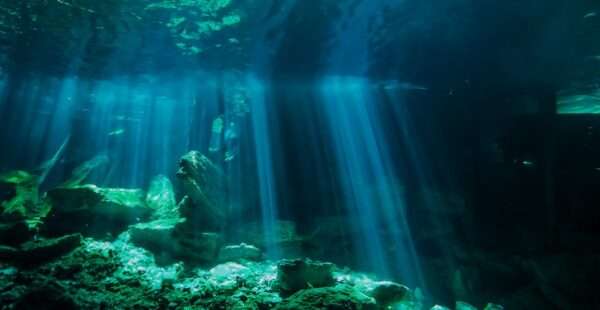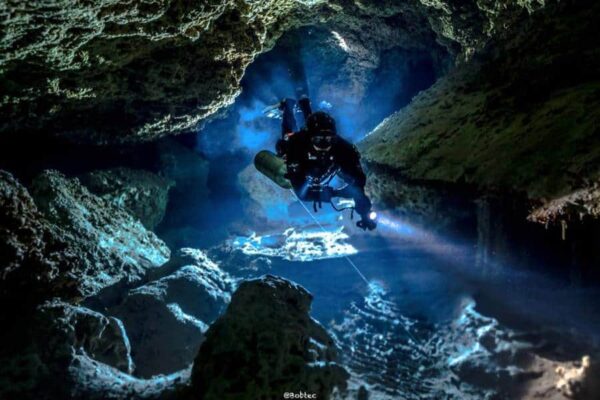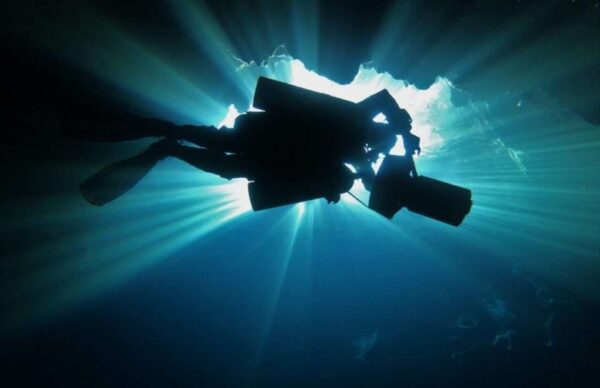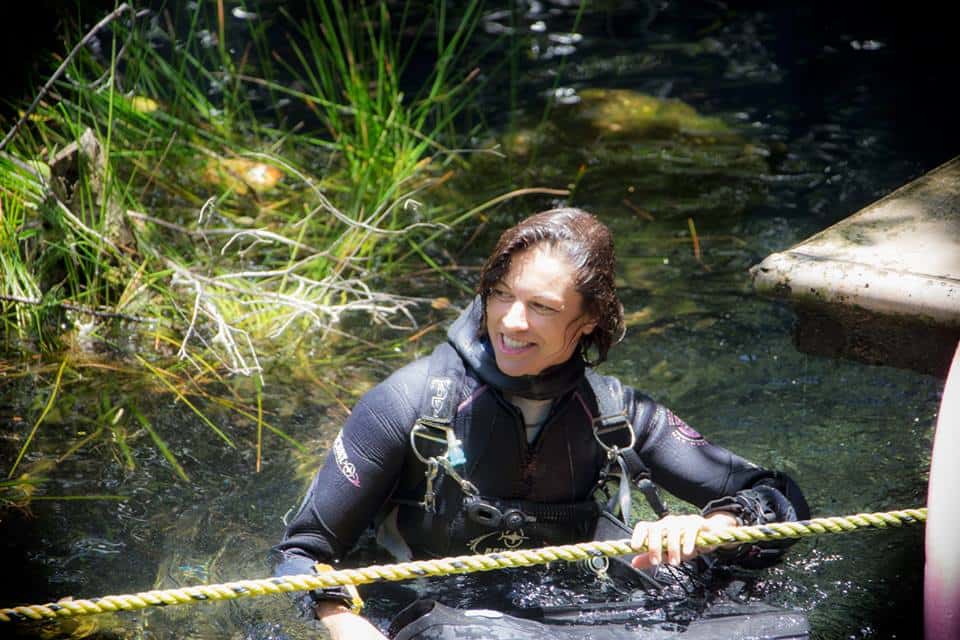Mexico is a dream destination for passionate cave divers, and we couldn’t resist! Our love for this thrilling pursuit led us to settle in Playa del Carmen, the heart of cave divers’ heaven, where we dive daily in the stunning cenotes.
If you’re an adventurous spirit eager to explore overhead environments, our Cave Diving Training in Mexico, on the Yucatan Peninsula, is your gateway. The Yucatan is home to the world’s longest underwater cave systems and offers endless exploration opportunities. At Deep Dark Diving, we share our passion by guiding you through the cenotes with a strong commitment to safety and conservation.
Cave diving is challenging yet incredibly rewarding, and Cenotes offer ideal cave diving training conditions. [Find out more about the advantages of dive training in Mexico].
Be warned—cave diving in Mexico is addictive! But with our focus on safety, you’ll be in good hands as we share our passion. Check out our training programs to start or continue your cave diving journey.
CAVE DIVING TRAINING IN MEXICO
Start your cave diving adventure with the TDI Cavern Diver course. Master essential skills, tackle challenges, and explore the cavern zone safely. This course is your first step into the world of cave diving
The TDI Intro-to-Cave Diver course enhances your skills for diving beyond the daylight zone. You’ll master line navigation, zero visibility, gas management, and emergency procedures, all while learning to manage the risks of overhead environments.
The TDI Full Cave Diver course sharpens your skills for navigating the challenges of deep cave environments. You’ll master passing restrictions, complex navigation, zero visibility, and emergency procedures, all while managing the specific risks of cave diving
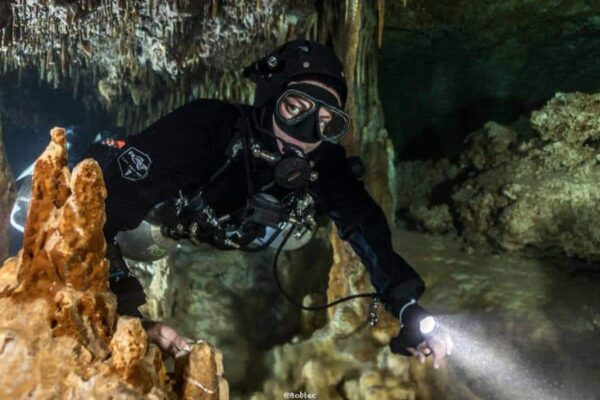
For Cave divers who wish to practice Safety Protocols in Side Mount
You are a trained cave diver, making the move to sidemount cave diving
ADVANCED CAVE DIVING TRAINING IN MEXICO
Full Cave dives with complex navigation, restrictions and extended penetration. Learn Razor-specific skills and the modern approach to cave diving in Side Mount. This challenging training is a strong foundation for all levels of cave diving.
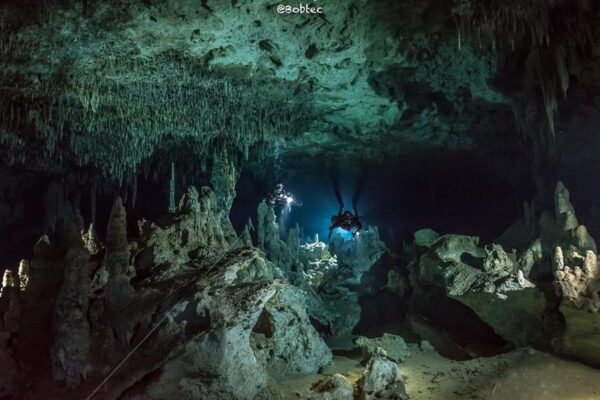
The Deco Cave course is intended to train divers in decompression strategies and emergency management for cave
diving
As an experienced full cave diver, you might find two tanks limiting your penetration and dive time. Our stage cave course teaches you to extend your penetration with stage cylinders, allowing for longer, further, and deeper explorations. with increased safety
The TDI DPV Cave Diver course refines your skills for using a Diver Propulsion Vehicle in caves. You’ll master advanced navigation, gas management, and emergency procedures while tackling the unique challenges of DPV use in overhead environments.
CONTACT US TODAY FOR YOUR CAVE AND TECH DIVING JOURNEY!
CAVERN DIVER CERTIFICATION
The TDI Cavern Diver Course is the foundation of the extensive Full Cave Diving Training Program and opens doors to further enrich your cenote diving experiences.
Contact your instructor and follow their advice. Choose your configuration and your gear wisely. There are many equipment options, but some are more performant than others and will help you improve core skills for cave diving and technical diving training.
The times and duration for the Cavern Diver Training are given as an indication of the minimum required standards. When you engage in technical diving, we expect full proficiency in all aspects of cavern diving before receiving your certification.
With your cavern diver certification, you can Consider advancing your skills with the Intro to Cave Diver Training or even pursuing the ultimate challenge of Full Cave Diver training in Mexico.
PREREQUISITES
- Minimum age 18, 15 with parental consent
- Provide proof of an SDI Open Water Scuba Diver or equivalent
- Proof of 25 logged dives
DURATION
- 3 Days minimum
- 4 cavern dives
- Total bottom time: 80min
- 6 hours Theory + elearning*
QUALIFICATIONS
- Daylight zone
- 1/3 of single tank or 1/6th of dual tanks
- Penetration max: 61m/200ft from surface
- Max depth: 40 m/130 ft
- No decompression dives
- No restrictions
- Single continuous guideline
- No removal of life support
- Qualified to enroll in Introductory Cave diving course
GEAR
- Single cylinder or Dual cylinders
- Regulator
- Buoyancy compensator device (BCD)
- Exposure suit
- Masks and fins
- 2 Line cutting devices
- 2 Safety spools
- 1 primary reel
- 2 battery powered lights
- 2 Computer or bottom timer
- Slate/wetnotes + pencil
- 3 directional + 3 non directional markers
*TDI e-learning at your own pace before the start of your training
*START is an acronym for S-drill (Out of Gas drill and Bubble Check), Team (buddy equipment
checks), Air (gas matching), Route (entry/exit and planned path underwater, Tables (depth,
duration, waypoints and schedule)
WHAT’S INCLUDED
- All dives
- Academics*
- Tanks (with 21% or 32%)
- Weights
- Transport to the dive site
- Drinking water
- Oxygen on-board
NOT INCLUDED
- e-learning
- Pick up
- Cenote entrance fees
- Certification Fee
- Equipment
- O2 for decompression, Trimix (for student and instructor)
- DPV Rental
ACADEMICS
- Policy for cavern diving
- Gas management
- Psychological Considerations
- Equipment considerations
- Communication (light and hand signals, touch contact)
- Physiology
- Cavern environment and conservation
- Problem-solving (Emergency procedures: Air share, Equipment failure, Silting conditions…)
LAND DRILLS
- Properly deploy a guideline
- Properly follow a guideline with eyes open and closed (simulating loss of visibility)
- Team Communication (light and hand signals, touch contact)
- Team dynamic
SKILLS
- Body posture/trim
- Buoyancy control
- Positionning
- Communication
- GuideLine use (deploy, follow with eyes opened and closed)
- Propulsion and anti-silting techniques
- Gas management,
- Emergency procedures,
- Propulsion techniques,
- Line and reel utilization,
- Equipment management in various conditions and environments.
TRAINING CENOTES
- Cenote Eden,
- Cenote Kukulkan
- Cenote Xtabay
- Cenote Carwash
- Cenote Chikin Ha
- Cenote XTabay,
- Cenote Taj Ma Ha
- Cenote Chac Mool
- and more…
CONTACT US TO START YOUR CAVERN DIVING TRAINING IN THE CENOTES!
INTRO TO CAVE DIVER CERTIFICATION
After experiencing cavern diving and venturing into the world of overhead environments, it’s time to elevate your diving skills with the TDI Intro to Cave Diver Course in the Cenotes, the best training ground in the world located in the heart of the longest cave systems in the world! Throughout all cave diving training, safety remains the utmost priority. You’ll learn to assess potential risks and make informed decisions, including when to abort a dive if unfavorable conditions become.
PREREQUISITES
- Minimum age 18, 15 with parental consent
- TDI Cavern Diver Certification or equivalent
- Proof of 25 logged dives
- Sidemount Diving Certification, Razor Sidemount Certification or Intro to Tech certification
DURATION
- 3 Days minimum
- 4 Intro to Cave dives minimum
- Total bottom time of 100 minutes
- 4 hours Theory*
QUALIFICATIONS
- Penetration to 1/3 of a single cylinder or 1/6th of double cylinders
- Max depth: 40 m/130 ft
- No decompression diving
- No restrictions
- Single Continuous guideline
- No removal of life support
GEAR
- Dual cylinders: Sidemount or Backmount
- 2 Regulators
- Buoyancy compensator device (BCD)
- Exposure suit
- Masks and fins
- 2 Line cutting devices
- 2 Safety spools
- 1 primary reel
- 1 primary light
- 2 battery powered back up lights
- 2 Computer/bottom timer
- Slate/wetnotes + pencil
- 3 directional + 3 non directional markers
ACADEMICS
- Policy for cavern diving
- Gas management
- Psychological Considerations
- Equipment considerations
- Communication (light and hand signals, touch contact)
- Physiology
- Cavern environment and conservation
- Problem-solving (Emergency procedures: Air share, Equipment failure, Silting conditions…)
LAND DRILLS
- Properly deploy a guideline
- Properly follow a guideline with eyes open and closed (simulating loss of visibility)
- Team Communication (light and hand signals, touch contact)
- Team dynamic
- Lost or broken line scenario
- Team separation
SKILLS
- Fine tuning all skills learned during the Cavern Diver Course
- Line handling and line protocols.
- Buoyancy control techniques
- Environmental awareness.
- Communication skills
- Lost or broken line scenario
- Team separation scenario
- Safe cave diving experience
- Emergency scenarios
TRAINING CENOTES
- Cenote Eden,
- Cenote Kukulkan
- Cenote Xtabay
- Cenote Carwash
- Cenote Chikin Ha
- Cenote XTabay,
- Cenote Taj Ma Ha
- Cenote Chac Mool
- and more…
CONTACT US FOR YOUR INTRO TO CAVE CAVE DIVING TRAINING IN THE CENOTES!
FULL CAVE DIVER CERTIFICATION
The TDI Full Cave Diver Course is the third stage of overhead environment dive training.
You already hold a Cavern Diver certification and Intro to Cave Diver certification, then you are ready to engage in the final step of becoming a Full Cave Diver.
During the Full Cave Diver training, you will learn advanced cave dive planning and in-water execution. In particular, you will learn complex navigation techniques, then safely navigate from the mainline to the side passages while performing performing jumps, gaps, traverses, and circuits. You will also pass restrictions and penetrate deeper into the cave systems as you start managing the rule of thirds.
PREREQUISITES
- Minimum age 18
- Minimum certification as a TDI Introductory Cave Diver Certidication or equivalent.
DURATION
- 5 Days minimum
- 8 full cave dives
- Total bottom time of 240 minutes
- Confined water
- Land drills
- 6 hours Theory*
QUALIFICATIONS
- Penetration to 1/3
- Max depth: 40 m/130 ft
- No decompression diving (unless Deco Procedures certified)
- Continuous guideline
- No equipment removal in cave
GEAR
- Dual cylinders: Sidemount or Backmount
- 2 Regulators
- Buoyancy compensator device (BCD)
- Exposure suit
- Masks and fins
- 2 Line cutting devices
- 2 Safety spools
- 1 primary reel
- 1 primary light
- 2 battery powered back up lights
- 2 Computer/bottom timer
- Slate/wetnotes + pencil
- 6 directional + 6 non directional markers
- Spools for Jumps and Gaps
ACADEMICS
- Policy for Cave Diving
- Gas Matching Procedures and Management to Include Dissimilar Volumes
- Psychological Considerations
- Equipment considerations
- Physiology
- Cave Environment and conservation
- Problem-solving
- Accident Analysis
- Review of Dive Tables and Decompression Theory
- Cave Diving Etiquette
LAND DRILLS
- Deploy a guideline
- Follow a guideline with eyes open and closed (loss of visibility)
- Team Communication (light and hand signals, touch contact)
- Team dynamic
- Lost or broken line
- Use of safety reel in Team separation procedures
- Jumps, Gaps and Ts
- Pre-dive planning
SKILLS
- Equipment check, and equipment matching
- Bubble check
- Line handling and line protocols
- Use of line markers
- Buoyancy and trim control
- Environmental awareness
- Communication skills
- Air share (eyes open and using touch contact)
- Replace mask while in contact with guideline
- Referencing as back-up navigation
- Anti-silting techniques
- Jumps, TS and gaps
- Lost or broken line
- Team separatio
- Emergency scenarios
TRAINING CENOTES
- Cenote Eden,
- Cenote Kukulkan
- Cenote Xtabay
- Cenote Carwash
- Cenote Chikin Ha
- Cenote XTabay,
- Cenote Taj Ma Ha
- Cenote Minotauro
- Cenote Taak Bi Ha
- Cenote Naharon
- Cenote Xunan Ha
- and more…
CONTACT US FOR YOUR FULL CAVE DIVING TRAINING IN THE CENOTES!
SIDE MOUNT CAVE DIVER CERTIFICATION
This course is designed to teach certified cave divers how to safely utilize side-mounted primary cylinders as an alternative to the traditional back-mounted configuration.
PREREQUISITES
- Minimum age 18
- Minimum certification as a TDI Side Mount certification AND Full cave Certification or equivalent.
- Min 25 Full cave dives
- Own an approved Side Mount system
DURATION
- 4 Days minimum
- 6 sidemount Full cave dives min
- minimum bottom time: 90 minutes.
- 4 hours Theory
QUALIFICATIONS
- Penetration to 1/3
- Max depth: 40 m/130 ft
- No decompression diving (unless Deco Procedures certified)
- Continuous guideline
- No equipment removal in cave
- Planned dives do not exceed diver’s current certification level
GEAR
- 2 regulators (first and second stage, SPG)
- Buoyancy compensator device
- Exposure suit (7mm or drysuit)
- Masks and fins
- 2 Line cutting devices
- 2 Safety spools (30 m/100 feet)
- 1 primary reel
- 1 primary light
- 2 back up lights
- 2 Computer/bottom timer
- Slate/wetnotes + pencil
- 6 directional + 6 non directional markers
- Jumps Spools
ACADEMICS
- Gas matching procedures to include dissimilar volumes.
- Gas management utilizing independent cylinders.
- Psychological considerations.
- Equipment considerations (Cylinder, Regulator, Buoyancy compensator / harness, Reel, Proper weighting, Equipment configurations)
- Communication (Hand and Light signals, Touch contact)
- Problem solving (Gas-sharing, Gas hemorrhages, Light failure, Loss of visibility, Entanglement, Self rescue)
- Tight spaces
- Conservation
- Difficult water entries
- S-Drills (specific to sidemount).
LAND DRILLS
- Deploy a guideline
- Follow a guideline with eyes open and closed (loss of visibility)
- Team Communication (light and hand signals, touch contact)
- Team dynamic
- Lost or broken line scenario
- Team separation procedures
- Jumps, Gaps and Ts
- Pre-dive planning
SKILLS
- Use START* before every dive
- Stress analysis and mitigation
- No-silting propulsion techniques (frog kick, modified frog kick, modified flutter kick, backwards kick, helicopter turns, and hand pulling)
- Buoyancy control (hover at fixed position in water column
without moving hands or feet) - Trim (ability to maintain proper position during the descent, bottom
and ascent portion of the dive) - Perform all skills while maintaining trim and
buoyancy in the water column (Unclipping and attaching sidemount cylinders, Gas switches with and without a mask) - Safely manage gas in independent cylinders.
- Conservation, awareness, and back referencing
TRAINING CENOTES
- Cenote Eden,
- Cenote Kukulkan
- Cenote Xtabay
- Cenote Carwash
- Cenote Chikin Ha
- Cenote XTabay,
- Cenote Taj Ma Ha
- Cenote Minotauro
- Cenote Taak Bi Ha
- Cenote Naharon
- Cenote Xunan Ha
- and more…
CONTACT US FOR YOUR SIDE MOUNT CAVE DIVING TRAINING IN THE CENOTES!
RAZOR SIDE MOUNT CAVE DIVER CERTIFICATION
The Razor Side Mount Cave Diving Course allows you to experience the freedom and flexibility of diving Side Mount in a cave at its best.
The Razor harness and wing combined were designed by expert cave divers and cave explorers Steve Bogaerts and HP Hartmann, cofounders of Go Side Mount.
Years of experience and hours of side mount cave diving and cave exploration led to the Razor Side Mount System development. And along with it appeared the necessity of developing a cave course program to be taught by experienced cave diving instructors committed to high-quality standards: certified Razor cave instructors.
Deep Dark Diving is proud to be part of the team of Razor Cave Instructors (Géraldine Solignac, Razor Side Mount Instructor) and to be able to share that knowledge with you and share all the fun that goes with it.
PREREQUISITES
- Minimum age 18
- Minimum Razor Sidemount Diver certification
- Own personnal Razor (can be purchased through Deep Dark Diving)
DURATION
- 8 Days minimum (Comprehensive Cave Diving Training)
- 16 Razor Side Mount cave dives min
- Total bottom time of 420 minutes
- 12 hours Theory*
QUALIFICATIONS
- Penetration to 1/3
- Max depth: 40 m/130 ft
- No deccompression dives unless Deco Procedures certified – Razor Cave and TDI Deco Procedures can be taught concurrently.
- Continuous guideline
- No equipment removal in cave with the exception of the stage cylinders
GEAR
- Dual cylinders: Sidemount
- 2 Regulators
- Full Razor Side Mount System including Pouch
- Exposure suit
- Masks and fins
- 2 Line cutting devices
- 2 Safety spools
- 1 primary reel
- 1 primary light
- 2 battery powered back up lights
- 2 Computer/bottom timer
- Slate/wetnotes + pencil
- 6 directional + 6 non directional markers
- Helmet
- Hand mount recommended
ACADEMICS
- Policy for Cave Diving.
- Gas Matching Procedures and Management to Include Dissimilar Volumes
- Psychological Considerations
- Equipment considerations
- Communication (light and hand signals, touch contact)
- Swimming Techniques
- Physiology
- Cave Environment and conservation
- Problem-solving
- Accident Analysis
- Review of Dive Tables and Decompression Theory
- Cave Diving Etiquette
LAND DRILLS
- Properly deploy a guideline
- Properly follow a guideline with eyes open and closed (simulating loss of visibility)
- Team Communication (light and hand signals, touch contact)
- Team dynamic
- Lost or broken line scenario
- Use of safety reel in Team separation procedures
- Jumps, Gaps and Ts
SKILLS
- Pre-dive planning
- Equipment check, and equipment matching
- Bubble check
- Line handling and line protocols
- Use of line markers
- Buoyancy and trim control
- Environmental awareness
- Communication skills
- Gas share (eyes open and using touch contact)
- Replace mask while in contact with guideline
- Referencing as back-up navigation
- Anti-silting techniques
- Perform jumps and gaps
- Lost or broken line
- Team separation
- Safe cave diving
- Emergency scenarios
- Regulator switches with one hand
- Usa of the Back up bladder
- Bungee replacement
- Other Razor specific skills…
TRAINING CENOTES
- Cenote Eden,
- Cenote Kukulkan
- Cenote Xtabay
- Cenote Carwash
- Cenote Chikin Ha
- Cenote XTabay,
- Cenote Taj Ma Ha
- Cenote Minotauro
- Cenote Taak Bi Ha
- Cenote Naharon
- Cenote Xunan Ha
- and more…
CONTACT US FOR YOUR RAZOR SIDE MOUNT CAVE DIVING TRAINING!
Razor 4 is out! Contact us to get yours!
CAVE DECOMPRESSION DIVING CERTIFICATION
PREREQUISITES
- Minimum age 18
- Full cave Diver Certification
- Stage Cave Diver certification recommended
- TDI Nitrox Diver or equivalent – Adv Nitrox recommended
- Own personnal Cave Diver Gear (can be purchased through Deep Dark Diving)
- TDI Advanced Nitrox e-learning
- TDI Deco Procedures e-learning
DURATION
- 3 Days minimum
- 4 Deco Cave Dives minimum
- 4 hours Theory
QUALIFICATIONS
- Graduates will be qualified to conduct decompression dives in the cave environment only utilizing 100% oxygen to accelerate decompression
- Maximum Depth 30m/100ft or 40m/100ft with END < 100ft with Trimix
- Continuous guideline
- No equipment removal in cave (except stages and Deco tank)
GEAR
- Dual cylinders: Sidemount or Backmount
- 2 Regulators
- Buoyancy compensator device (BCD)
- Stage cylinder
- Stage regulator (first and second stage + pressure gauge)
- Exposure suit
- Masks and fins
- 2 Line cutting devices
- 2 Safety spools
- 1 primary reel
- 1 primary light
- 2 battery powered back up lights
- 2 Computer/bottom timer
- Slate/wetnotes + pencil
- 6 directional + 6 non directional markers
- Helmet
ACADEMICS
- Overview of Decompression Safety Stops Compared to Required Stops
- Physics
- Physiology
- Equipment considerations
- Decompression Options
- Tables vs Computers
- Dive Planning
- Procedures (staged deco, gas switch, back gas break)
- Emergency Procedures
LAND DRILLS
- Analysis and labeling of decompression cylinders
- Dropping decompression cylinders
- Retrieving decompression cylinders
- Gas switches
SKILLS
- Drop deco cylinders
- Calculate and communicate deco obligation
- Perform staged decompression ascents
- Retrieve deco cylinder
- Gas switches
- Emergency Procedures
- Adjusting ascent profile on the fly
- Decompression Regulator failure
- Lost decompression gas
TRAINING CENOTES
- Cenote Eden,
- Cenote Xtabay
- Cenote Carwash
- Cenote Taj Ma Ha
- Cenote Naharon
- Cenote Cocom
- and more…
CONTACT US FOR YOUR STAGE CAVE DIVING IN THE CENOTES
STAGE CAVE DIVING CERTIFICATION
The TDI Stage Cave Diver Course is meant for trained and experienced Full cave divers who wish to extend their bottom times or penetration distance using stage cylinders. It requires efficient gas management and due to the extended time at depth, possibly different gas mixtures. You will learn to plan dives with longer bottom times, complex dive planning, and multiple methods of gas management. The course dives will be within your current certification and experience regarding depth, gas mixes, and required decompression.
The course covers handling the extra tank, gas management based on team configuration, and team communication during dropping and retrieval procedures, with emphasis on team positioning and awareness.
Check out our Cave Deco Training for more advanced Training.
PREREQUISITES
- Minimum age 18
- TDI Full Cave Diver certification, or Razor Cave Diver certification or equivalent
- Own personnal Cave Diver Gear (can be purchased through Deep Dark Diving)
DURATION
- 4 Days minimum
- 3 stage cave dives min
- 4 hours Theory
QUALIFICATIONS
- Penetration is limited to the 1/3 air rule, or more conservative air-plan at instructor’s discretion
- Students are encouraged to gain experience before attempting to plan and execute complex stage cave dives
- Max depth: 40 m/130 ft
- No decompression diving (unless Deco Procedures and Cave Deco certified)
GEAR
- Dual cylinders: Sidemount or Backmount
- Two independent first and second stage regulators; one regulator equipped with a long hose
- Buoyancy compensator device (BCD)
- Stage cylinder
- Stage regulator (first and second stage + pressure gauge)
- Exposure suit
- Masks and fins
- 2 Line cutting devices
- 2 Safety spools
- 1 primary reel
- 1 primary light
- 2 battery powered back up lights
- 2 Computer/bottom timer
- Slate/wetnotes + pencil
- 6 directional + 6 non directional markers
- Helmet
ACADEMICS
- Motivations for extended time and penetration
- Equipment considerations: Cylinder sizes, Rigging, Streamlining
- Gas planning and gas management techniques
- Dive planning including decompression obligations (if course is taught in conjunction with Deco Cave or Deco Procedures)
- Stage Diving techniques (Dropping and retrieving of stage, Drop-off stations)
LAND DRILLS
- Pre-dive planning
- Equipment check
SKILLS
- Equipment matching
- Bubble check.
- Specialized propulsion techniques in varying types of flow.
- Buoyancy control.
- Trim and body posture.
- Stress analysis (detection and management)
- use of stage cylinders
- Dropping and retrieval of stage cylinders
- Awareness
- Respect for the cavern environment
TRAINING CENOTES
- Cenote Eden,
- Cenote Kukulkan
- Cenote Xtabay
- Cenote Carwash
- Cenote Chikin Ha
- Cenote XTabay,
- Cenote Taj Ma Ha
- Cenote Minotauro
- Cenote Taak Bi Ha
- Cenote Naharon
- Cenote Xunan Ha
- and more…
CONTACT US FOR YOUR STAGE CAVE DIVING IN THE CENOTES
CAVE DPV DIVING CERTIFICATION
This course is designed to teach trained cave divers how to utilize Diver Propulsion Vehicles (DPVs) in the cave environment. Divers will learn about safe DPV use, DPV components, and care and maintenance. Students will learn to plan dives that may incorporate extended penetration, longer bottom times, complex dive planning, and proper methods of gas management.
PREREQUISITES
- Minimum age 18
- Certified as a TDI Stage Cave Diver or equivalent
- Provide proof of at least 25 non-training full cave dives
- Own personnal Cave Diver Gear (can be purchased through Deep Dark Diving)
DURATION
- 3 Days minimum
- 3 DPV Cave dives minimum
- Total bottom time of 90 minutes
- 4 hours Theory
QUALIFICATIONS
- Single DPV*
- each diver must turn the dive with no less than twice the amount of gas required to exit the cave while swimming
- Max depth: 40 m/130 ft
- No decompression diving (unless Deco Procedures certified)
- No restrictions
- Continuous guideline
- No equipment removal in cave (except stages and DPV)
* DPV Cave divers should gain experience before attempting to plan and execute complex DPV cave dives that would require the use of a back-up DPV
GEAR
- Dual cylinders: Sidemount or Backmount
- Two independent first and second stage regulators; one regulator equipped with a long hose
- Buoyancy compensator device
- Stage cylinder
- Stage regulator (first and second stage + pressure gauge)
- Exposure suit
- Masks and fins
- 2 Line cutting devices
- 2 Safety spools
- 1 primary reel
- 1 primary light
- 2 battery powered back up lights
- 2 Computer/bottom timer
- Slate/wetnotes + pencil
- 6 directional + 6 non directional markers
- Helmet for Side Mount divers
- DPV configured for the cave environment
ACADEMICS
- Motivations for DPV cave diving
- Advantages of DPV use
- Equipment considerations (DPV options, DPV components
- Problem solving procedures (DPV malfunction or failure, Towing)
- Environmental considerations (Appropriate vs. inappropriate passages, Suitable cave conditions)
- DPV diving techniques (Buoyancy and trim with DPV, Dropping, securing, and retrieving a DPV)
- Dive planning and gas management
LAND DRILLS
- Demonstrate adequate pre-dive planning
- Equipment check and equipment matching
SKILLS
- Bubble check
- Propulsion techniques in varying types of flow
- Buoyancy control
- Trim and body posture
- Stress analysis (detection and management)
- Share gas with DPVs while maintaining visual contact with the guideline.
- Simulate primary light failure and exit utilizing the DPV and the smallest backup light
- Simulate exiting the cave with disabled DPV
- Exit while towing a team member and his disabled DPV
TRAINING CENOTES
- Cenote Eden,
- Cenote Kukulkan
- Cenote Xtabay
- Cenote Carwash
- Cenote Chikin Ha
- Cenote XTabay,
- Cenote Taj Ma Ha
- Cenote Minotauro
- Cenote Taak Bi Ha
- Cenote Naharon
- Cenote Xunan Ha
- and more…
CONTACT US FOR YOUR STAGE CAVE DIVING IN THE CENOTES
CAVERN DIVING INSTRUCTOR & CAVE DIVING INSTRUCTOR
The TDI Cavern Diving Instructor Evaluation Course is the first in a series of overhead courses. It takes a serious look at the professionalism and skills of the Instructor candidates. They are evaluated for their knowledge and proficiency in presenting a TDI Cavern course and in demonstrating land and water skills. The evaluator focuses on the overall attitude towards safety and considers the candidate’s ability to develop skilled, efficient, and well-educated cavern divers who are aware of the environmental impact that divers may have in cavern systems.
The purpose of this program is to evaluate a candidate instructor with respect to the following criteria:
– Level of knowledge, professionalism and proficiency in presenting a comprehensive TDI Cavern Diver program
– Proficiency in demonstrating the required land and water skills.
– Overall attitude toward safety, both for the instructor and their student.
– Reducing the long-term environmental impact of our sport by developing skilled, efficient and well-educated divers.
– Possessing a thorough knowledge of the standards and procedures of TDI.
CONTACT US FOR CAVE DIVING INSTRUCTOR RATINGS
PREREQUISITES
- Minimum age 21
- Open water instructor in active teaching status for at least 1 year
- TDI Nitrox Instructor or equivalent; a TDI Full Cave certification or equivalent (NACD or NSS-CDS)
- Provide proof of at least 100 full cave dives
- Teaching min 4 TDI courses and assisting with a minimum of 1 complete TDI Cavern Diver course with 1 active TDI Cave Diver Instructor
- Recommendation from a TDI Cave Instructor with which the candidate has assisted in cavern training
- Own Full Cave Equipment
DURATION
- Minimum 2 cavern dives
- Minimum 15 hours
QUALIFICATIONS
- Teach and certify students in the TDI Overhead Environment/ Cavern Diver course
GEAR
- Dual cylinders: Sidemount or Backmount
- 2 Regulators
- Buoyancy compensator device (BCD)
- Stage cylinder
- Stage regulator (first and second stage + pressure gauge)
- Exposure suit
- Masks and fins
- 2 Line cutting devices
- 2 Safety spools
- 1 primary reel
- 1 primary light
- 2 battery powered back up lights
- 2 Computer/bottom timer
- Slate/wetnotes + pencil
- 3 directional + 3 non directional markers
- Helmet
ACADEMICS
- Policy of Cavern Diving
- Gas Matching Procedures/Management
- Accident Analysis
- Psychological Considerations
- Equipment Considerations (Body posture and buoyancy control)
- Communication (Hand signals, Light signals, Touch Contact)
- Swimming Techniques
- Review of Problem Solving (Accident analysis, Equipment failure scenarios, Emergency procedures, Body posture/trim, Buoyancy control, Line following, Propulsion techniques)
- Review of Dive Tables/Computers
- Physiology (Breathing techniques, Stress management)
- Cave Environment/Conservation
- Landowner Relations
- Local Access Requirements
LAND DRILLS
- Proper use of reels; primary, safety
- Simulated situations/emergencies including: Air sharing, Line entanglement, Broken or cut guideline, Primary light failure, Valve-regulator failure, Fin and mask failures
- Communication: Light, Hand and touch
- Candidates are required to present a minimum of 2 lectures, 1 prepared and 1 impromptu, from the TDI Diving in Overhead Environments Diver materials
PRE-DIVE SKILLS
- Dive planning to include conservative decompression procedures and proper diver etiquette on all dives
- Pre-dive briefing, air supply and equipment matching, bubble check, air- sharing, and post-dive critique.
SKILLS
- Buoyancy control, body posture, and propulsion techniques
- Communication with use of light/hand signals
- Air-sharing drill in (Full visibility situation, lights out, eyes closed situation using a single-file swimming method and touch contact
- A lights out, eyes closed situation using a single-file swimming method and touch contact
- Use of reels; primary and safety
- Demonstrate proper stress identification and countermeasures
TRAINING CENOTES
- Cenote Eden,
- Cenote Kukulkan
- Cenote Xtabay
- Cenote Carwash
- Cenote Chikin Ha
- Cenote XTabay,
- Cenote Taj Ma Ha
- Cenote Minotauro
- Cenote Taak Bi Ha
- Cenote Naharon
- Cenote Xunan Ha
- and more…
CONTACT US FOR YOUR CAVE AND TECH DIVING JOURNEY!
OTHER DIVE TRAINING – INSTRUCTOR TRAINING
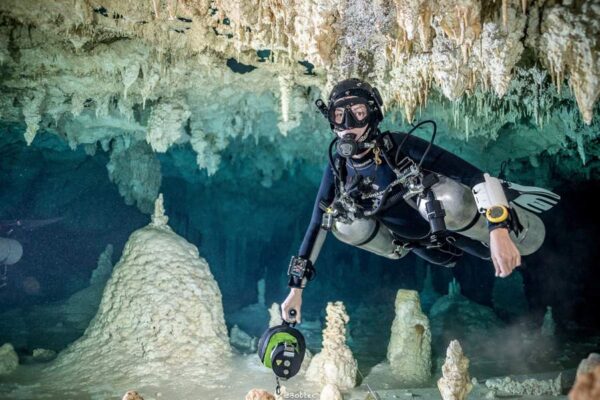
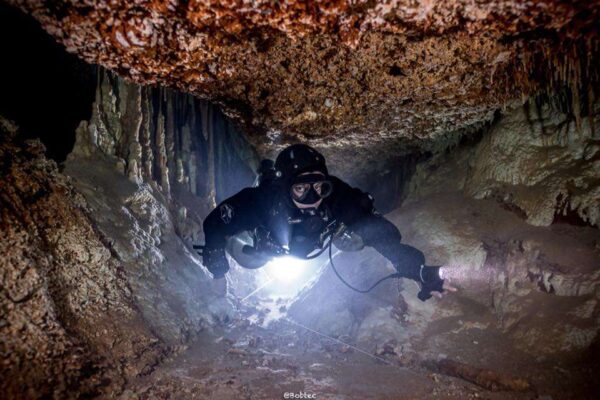
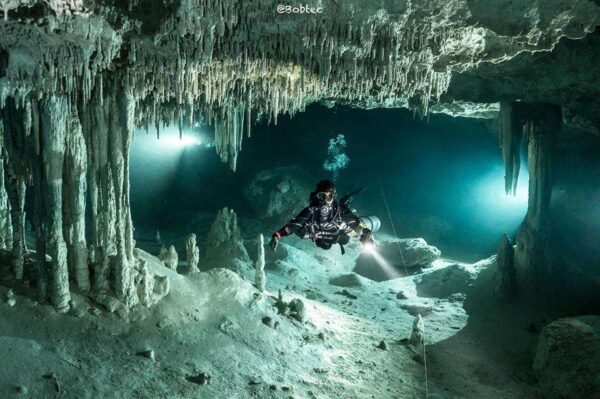
FREQUENTLY ASKED QUESTIONS ABOUT CAVE DIVING
What’s the difference between cavern diving and cave diving?
Cavern diving is limited within the “light zone,” so divers can always see natural light and exit points.
In contrast, cave diving involves deeper penetration beyond the light zone.
Both cavern and cave diving require specialized training to handle complete darkness, confined spaces, and navigation challenges.
Do I need sidemount training for cave diving?
Answer: NO.
Sidemount diving offers better maneuverability and streamlining. Many cave divers prefer it as it allows easy access to tanks and equipment redundancy, essential for safety in overhead environments. But Cave Diving in Backmount is perfectly fine and can even be the configuration of choice for Deeper and longer dives.
How long does it take to complete cave diving certification?
Answer: Depending on the level, certifications such as Cavern Diver, Intro to Cave, or Full Cave can take 4 to 8 days. Training is progressive, with each step building on skills like gas management, navigation, and problem-solving.
All skills must be performed with proficiency and might require extra training days.
What are the prerequisites for cave diving?
Answer: Basic requirements typically include Advanced Open Water certification and 25–50 logged dives. Nitrox training is often recommended, and students must demonstrate excellent buoyancy and awareness skills.
How do cave divers manage their air supply?
Answer: Cave divers use the Rule of thirds. During Cave Diving training, you will learn how to handle the Rule of thirds and how to adapt it to ensure you have enough gas in case of unforeseen issues during the dive.
What equipment is required for cave diving?
Answer: Key gear includes redundant systems (e.g., two regulators, backup lights), reels and spools for safety and navigation, and specialized configurations like side-mount or back-mount twin tanks. Advanced divers may also use DPVs (diver propulsion vehicles) and stage cylinders for extended range. Each level requires extra training or coaching.
Is cave diving dangerous?
Answer: While cave diving has inherent risks, it can be very safe with proper training, equipment, and protocol adherence. Studies show that most accidents occur when divers bypass safety rules or venture into caves without specialized training.
Where are the best places to train for cave diving?
Answer: Mexico’s Riviera Maya is home to some of the longest cave systems in the world, such as Ox Bel Ha and Sac Actun. It is considered one of the world’s top destinations for cave diving and cave diving training. The Cenotes’ clear waters, shallow depth, and extensive passage networks provide ideal conditions for both beginners and experienced divers.
Can I dive independently after cave diver certification?
Answer: While certified cave divers can dive independently, most cave diving instructors recommend additional guided cave dives with experienced local guides to build experience and confidence before venturing independently and being exposed to different cave diving scenarios. Certified cave divers should always dive with a buddy for safety reasons.
What techniques are essential for cave diving?
Answer: Some of the key techniques include:
- buoyancy control,
- effective use of navigation tools (reels, spools, line markers)
- adherence to gas management rules
- communication protocols
- Handling silt-out conditions
- practicing lost-line drills
How do divers prevent silting during cave dives?
Answer: Divers use careful frog kicks or modified flutter kicks to avoid disturbing the silt on the cave floor. Keeping fins away from the bottom and maintaining good buoyancy is essential to prevent a visibility-limiting silt-out event.
What should a diver do in case of a lost line?
Answer: Cave diving courses teach lost-line drills, where the diver uses touch contact to locate the guideline. A safety spool is deployed to connect to the primary line if the diver becomes separated from it, allowing them to find their way out safely.
Why is teamwork critical in cave diving?
Answer: Team dynamics are crucial, as buddies rely on each other for gas sharing, navigation, and communication. Effective pre-dive planning ensures each diver knows their role and what to do in emergencies, such as silt-outs or equipment failure.
What is gas matching, and why is it important?
Answer: Gas matching ensures that both divers have compatible gas reserves, accounting for the highest consumption rate. This practice guarantees that divers have enough air to exit together if one diver consumes more gas than expected.
How do divers communicate in caves?
Answer: Since voice communication is impossible, divers use hand signals, light signals, and touch contact to communicate. Cave diving training emphasizes the need for clear and consistent non-verbal communication to avoid misunderstandings underwater.
What are the psychological challenges of cave diving?
Answer: Stress management is critical. Training helps divers develop a calm, problem-solving mindset, emphasizing the importance of staying relaxed even under pressure to handle emergencies effectively.
What happens if a diver experiences a silt-out?
Answer: In zero visibility, divers follow the guideline using tactile contact, referred to as “touch contact,” until visibility improves. Practicing this skill is essential during training to ensure divers can navigate safely even in complete darkness.
What are siphons, and how do they affect cave diving?
Answer: Siphons are sections of caves where water flows inward, potentially creating strong currents that can make exits difficult. Divers are trained to recognize these areas during dive planning to account for the increased effort required to return safely.
How are dive plans structured in cave diving?
Answer: A dive plan includes mapping the route, gas management, depth limits, and emergency contingencies. Divers must adhere to the “rule of thirds” for air consumption, and plan decompression stops as needed for deeper or longer dives.
What specific hazards do cave divers face?
Answer: Cave diving involves unique risks, such as entanglement, silt-outs, getting lost, and equipment failure. Overhead environments prevent immediate surfacing, requiring divers to solve problems underwater and exit safely to the surface.

